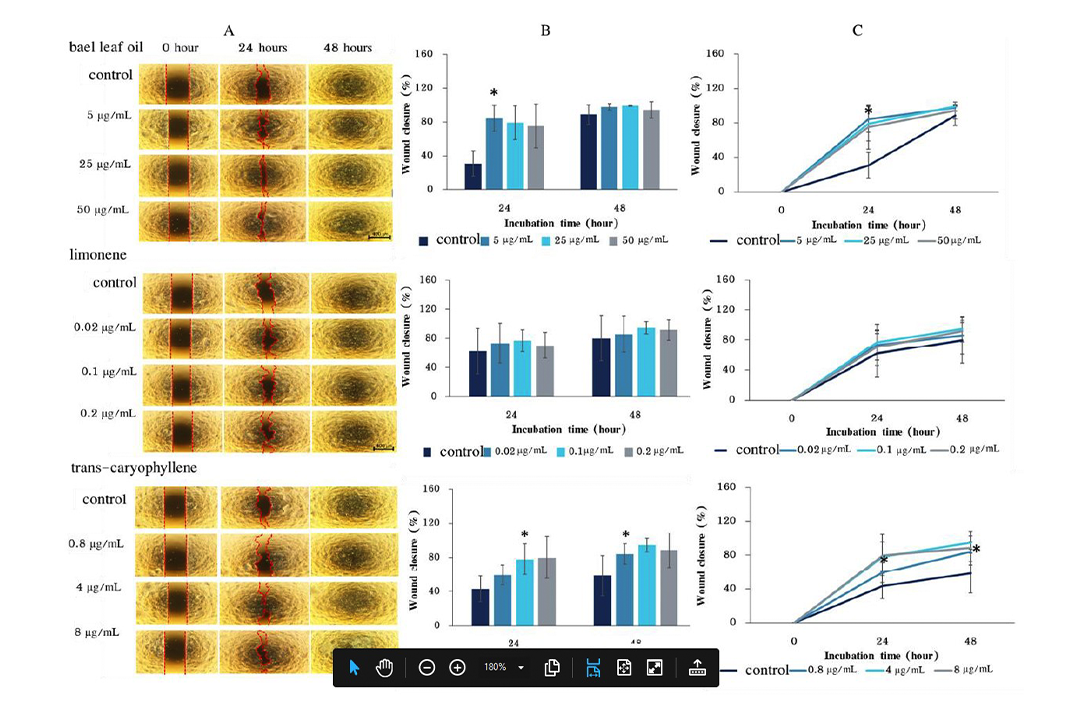Bael Leaf Oil Increases AQP3 Expression and Exerts Wound-Healing Effect in Human Immortalized Keratinocytes
DOI:
https://doi.org/10.14456/nujst.2023.26Keywords:
bael leaf oil, trans-caryophyllene, HaCaT, wound healing, aquaporin-3Abstract
Bael (Aegle marmelos L. Corrêa, Family Rutaceae) leaf oil has been reported to promote wound healing in keratinocyte cell models. The oil key components, according to GC-MS analysis, are trans-caryophyllene and limonene. In this study, we investigated the mechanism by which bael leaf oil and its key components aid wound healing by focusing on the water channel aquaporin-3 (AQP3), which is crucial for maintaining skin hydration and identifying the active component responsible for the activity. To this objective, keratinocyte (HaCaT) cells were grown in media containing 2% FBS and subjected to a wound healing assay. The expression of AQP3 mRNA in the cells was observed using RT-real-time PCR. The results demonstrated that trans-caryophyllene and bael leaf oil significantly stimulated keratinocytes to close the wound (p<0.05 vs. vehicle group) and enhanced the level of AQP3 mRNA expression. It suggests that trans-caryophyllene, at least among the components of bael leaf oil, enhances the wound healing action instigated by the bael leaf oil, and that this effect is associated with the water channel aquaporin-3.
References
Ahmad, M., Khan, T. H., Ansari, M. N., & Ahmad, S.F. (2014). Enhanced wound healing by topical administration of d-limonene in alloxan induced diabetic mice through reduction of pro-inflammatory markers and chemokine expression. BMC Genomics, 15(2), 29. http://dx.doi.org/10.1186/1471-2164-15-S2-P29
Boury-Jamot, M., Sougrat, R., Tailhardat, M., Le Varlet, B., Bonté, F., Dumas, M., & Verbavatz, J.M. (2006). Expression and function of aquaporins in human skin: Is aquaporin-3 just a glycerol transporter? Biochim Biophysic Acta, 1758(8), 1034-1042.
Boury-Jamot, M., Daraspe, J., Bonté, F., Perrier, E., Schnebert, S., Dumas, M., & Verbavatz, J.M. (2009). Skin aquaporins: function in hydration, wound healing, and skin epidermis homeostasis. Handbook of Experimental Pharmacology, 190, 205-17.
d'Alessio, P. A., Mirshahi, M., Bisson, J. F., & Bene, M. C. (2014). Skin repair properties of d-limonene and perillyl alcohol in murine models. Anti-Inflammatory & Anti-Allergy Agents in Medicinal Chemistry, 13(1), 29-35. http://dx.doi.org/10.2174/18715230113126660021
Francomano, F., Caruso, A., Barbarossa, A., Fazio, A., La Torre, C., Ceramella, J., … Sinicropi, M. S. (2019). β-Caryophyllene: a sesquiterpene with countless biological properties. Applied Sciences, 9(24), 5420.
Grada, A., Otero-Vinas, M., Prieto-Castrillo, F., Obagi, Z., & Falanga, V. (2017). Research techniques made simple: analysis of collective cell migration using the wound healing assay. Journal of Investigative Dermatology, 137(2), e11-e16.
Gushiken, L. F. S., Beserra, F. P., Hussni, M. F., Gonzaga, M. T., Ribeiro, V. P., de Souza, P. F., … Pellizzon, C. H. (2022). Beta-caryophyllene as an antioxidant, anti-inflammatory and re-epithelialization activities in a rat skin wound excision model. Oxidative Medicine and Cellular Longevity, 3, 9004014. http://dx.doi.org/10.1155/2022/9004014
Kadam, S., Vandana, M., & Kaushik, K. S., (2020). Reduced serum methods for contact-based coculture of human dermal fibroblasts and epidermal keratinocytes. BioTechniques, 69, 00–00. http://dx.doi.org/10.2144/btn-2020-0112
Kesornnoi, B., Prangsaengtong, O., & Sitthithaworn, W. (2022). Volatile oil from Aegle marmelos leaf facilitates wound healing in a human epidermal keratinocyte cell model. Proceeding on International Conference and Exhibition on Pharmaceutical Science and Technology held in Thammasat University, Patumthanee, Thailand 23-24 June 2022. Thailand: Faculty of Pharmacy, Thammasat University.
Koyama, S., Purk, A., Kaur, M., Soini, H. A., Novotny, M. V., Davis, K., … Mescher, A. (2019) Beta-caryophyllene enhances wound healing through multiple routes. PLoS ONE, 14(12), e0216104. http://dx.doi.org/10.1371/journal.pone.0216104
Jonkman, J. E., Cathcart, J. A., Xu, F., Bartolini, M. E., Amon, J. E., Stevens, K. M., & Colarusso, P. (2014). An introduction to the wound healing assay using live-cell microscopy. Cell Adhesion & Migration, 8(5), 440-451.
Liang, C. C., Park, A., & Guan, J. L. (2007). In vitro scratch assay: a convenient and inexpensive method for analysis of cell migration in vitro, Nature Protocol, 2, 329–333.
Livak, K. J., & Schmittgen, T. D. (2001). Analysis of relative gene expression data using real-time quantitative PCR and the 2ΔΔCt method. Methods, 25, 402-408.
Martinotti, S., Pellavio, G., Laforenza, U., & Ranzato, E. (2019). Propolis induces AQP3 expression: a possible way of action in wound healing. Molecules, 24(8), 1544. http://dx.doi.org/10.3390/molecules24081544.
Stamm, A., Reimers, K., Strauß, S., Vogt, P., Scheper, T., & Pepelanova, I. (2016). In vitro wound healing assays-state of the art. BioNanoMaterials, 17(1), 79–87.

Downloads
Published
How to Cite
Issue
Section
License
Copyright (c) 2023 Naresuan University Journal: Science and Technology (NUJST)

This work is licensed under a Creative Commons Attribution-NonCommercial 4.0 International License.













